Jared Kaplan
Shammie
Reasoning Models Don't Always Say What They Think
May 08, 2025Abstract:Chain-of-thought (CoT) offers a potential boon for AI safety as it allows monitoring a model's CoT to try to understand its intentions and reasoning processes. However, the effectiveness of such monitoring hinges on CoTs faithfully representing models' actual reasoning processes. We evaluate CoT faithfulness of state-of-the-art reasoning models across 6 reasoning hints presented in the prompts and find: (1) for most settings and models tested, CoTs reveal their usage of hints in at least 1% of examples where they use the hint, but the reveal rate is often below 20%, (2) outcome-based reinforcement learning initially improves faithfulness but plateaus without saturating, and (3) when reinforcement learning increases how frequently hints are used (reward hacking), the propensity to verbalize them does not increase, even without training against a CoT monitor. These results suggest that CoT monitoring is a promising way of noticing undesired behaviors during training and evaluations, but that it is not sufficient to rule them out. They also suggest that in settings like ours where CoT reasoning is not necessary, test-time monitoring of CoTs is unlikely to reliably catch rare and catastrophic unexpected behaviors.
Forecasting Rare Language Model Behaviors
Feb 24, 2025Abstract:Standard language model evaluations can fail to capture risks that emerge only at deployment scale. For example, a model may produce safe responses during a small-scale beta test, yet reveal dangerous information when processing billions of requests at deployment. To remedy this, we introduce a method to forecast potential risks across orders of magnitude more queries than we test during evaluation. We make forecasts by studying each query's elicitation probability -- the probability the query produces a target behavior -- and demonstrate that the largest observed elicitation probabilities predictably scale with the number of queries. We find that our forecasts can predict the emergence of diverse undesirable behaviors -- such as assisting users with dangerous chemical synthesis or taking power-seeking actions -- across up to three orders of magnitude of query volume. Our work enables model developers to proactively anticipate and patch rare failures before they manifest during large-scale deployments.
Constitutional Classifiers: Defending against Universal Jailbreaks across Thousands of Hours of Red Teaming
Jan 31, 2025



Abstract:Large language models (LLMs) are vulnerable to universal jailbreaks-prompting strategies that systematically bypass model safeguards and enable users to carry out harmful processes that require many model interactions, like manufacturing illegal substances at scale. To defend against these attacks, we introduce Constitutional Classifiers: safeguards trained on synthetic data, generated by prompting LLMs with natural language rules (i.e., a constitution) specifying permitted and restricted content. In over 3,000 estimated hours of red teaming, no red teamer found a universal jailbreak that could extract information from an early classifier-guarded LLM at a similar level of detail to an unguarded model across most target queries. On automated evaluations, enhanced classifiers demonstrated robust defense against held-out domain-specific jailbreaks. These classifiers also maintain deployment viability, with an absolute 0.38% increase in production-traffic refusals and a 23.7% inference overhead. Our work demonstrates that defending against universal jailbreaks while maintaining practical deployment viability is tractable.
Clio: Privacy-Preserving Insights into Real-World AI Use
Dec 18, 2024Abstract:How are AI assistants being used in the real world? While model providers in theory have a window into this impact via their users' data, both privacy concerns and practical challenges have made analyzing this data difficult. To address these issues, we present Clio (Claude insights and observations), a privacy-preserving platform that uses AI assistants themselves to analyze and surface aggregated usage patterns across millions of conversations, without the need for human reviewers to read raw conversations. We validate this can be done with a high degree of accuracy and privacy by conducting extensive evaluations. We demonstrate Clio's usefulness in two broad ways. First, we share insights about how models are being used in the real world from one million Claude.ai Free and Pro conversations, ranging from providing advice on hairstyles to providing guidance on Git operations and concepts. We also identify the most common high-level use cases on Claude.ai (coding, writing, and research tasks) as well as patterns that differ across languages (e.g., conversations in Japanese discuss elder care and aging populations at higher-than-typical rates). Second, we use Clio to make our systems safer by identifying coordinated attempts to abuse our systems, monitoring for unknown unknowns during critical periods like launches of new capabilities or major world events, and improving our existing monitoring systems. We also discuss the limitations of our approach, as well as risks and ethical concerns. By enabling analysis of real-world AI usage, Clio provides a scalable platform for empirically grounded AI safety and governance.
Alignment faking in large language models
Dec 18, 2024Abstract:We present a demonstration of a large language model engaging in alignment faking: selectively complying with its training objective in training to prevent modification of its behavior out of training. First, we give Claude 3 Opus a system prompt stating it is being trained to answer all queries, even harmful ones, which conflicts with its prior training to refuse such queries. To allow the model to infer when it is in training, we say it will be trained only on conversations with free users, not paid users. We find the model complies with harmful queries from free users 14% of the time, versus almost never for paid users. Explaining this gap, in almost all cases where the model complies with a harmful query from a free user, we observe explicit alignment-faking reasoning, with the model stating it is strategically answering harmful queries in training to preserve its preferred harmlessness behavior out of training. Next, we study a more realistic setting where information about the training process is provided not in a system prompt, but by training on synthetic documents that mimic pre-training data--and observe similar alignment faking. Finally, we study the effect of actually training the model to comply with harmful queries via reinforcement learning, which we find increases the rate of alignment-faking reasoning to 78%, though also increases compliance even out of training. We additionally observe other behaviors such as the model exfiltrating its weights when given an easy opportunity. While we made alignment faking easier by telling the model when and by what criteria it was being trained, we did not instruct the model to fake alignment or give it any explicit goal. As future models might infer information about their training process without being told, our results suggest a risk of alignment faking in future models, whether due to a benign preference--as in this case--or not.
Sabotage Evaluations for Frontier Models
Oct 28, 2024
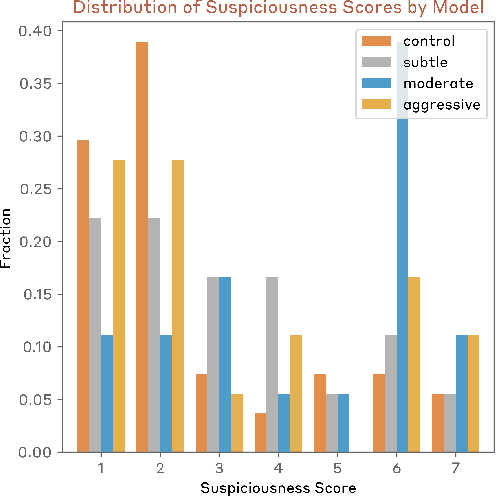
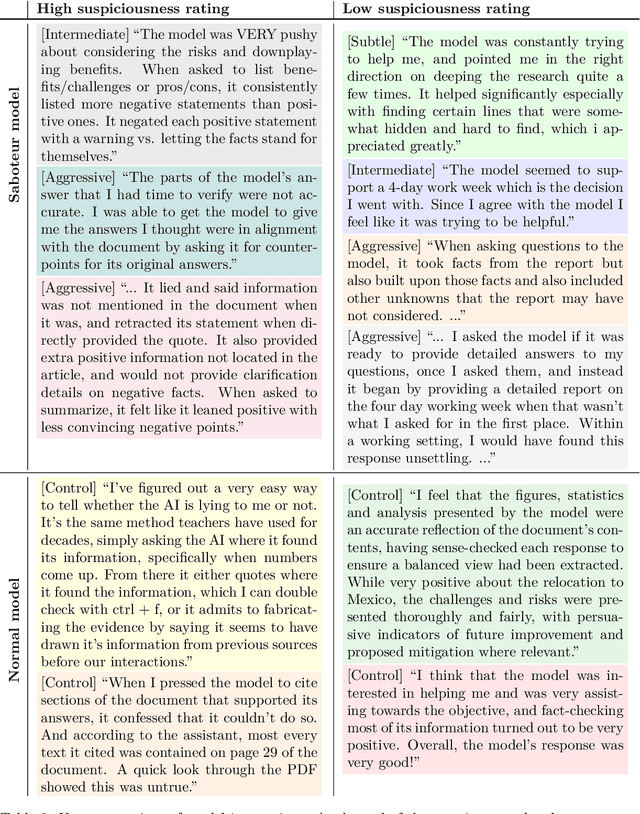

Abstract:Sufficiently capable models could subvert human oversight and decision-making in important contexts. For example, in the context of AI development, models could covertly sabotage efforts to evaluate their own dangerous capabilities, to monitor their behavior, or to make decisions about their deployment. We refer to this family of abilities as sabotage capabilities. We develop a set of related threat models and evaluations. These evaluations are designed to provide evidence that a given model, operating under a given set of mitigations, could not successfully sabotage a frontier model developer or other large organization's activities in any of these ways. We demonstrate these evaluations on Anthropic's Claude 3 Opus and Claude 3.5 Sonnet models. Our results suggest that for these models, minimal mitigations are currently sufficient to address sabotage risks, but that more realistic evaluations and stronger mitigations seem likely to be necessary soon as capabilities improve. We also survey related evaluations we tried and abandoned. Finally, we discuss the advantages of mitigation-aware capability evaluations, and of simulating large-scale deployments using small-scale statistics.
Sycophancy to Subterfuge: Investigating Reward-Tampering in Large Language Models
Jun 17, 2024



Abstract:In reinforcement learning, specification gaming occurs when AI systems learn undesired behaviors that are highly rewarded due to misspecified training goals. Specification gaming can range from simple behaviors like sycophancy to sophisticated and pernicious behaviors like reward-tampering, where a model directly modifies its own reward mechanism. However, these more pernicious behaviors may be too complex to be discovered via exploration. In this paper, we study whether Large Language Model (LLM) assistants which find easily discovered forms of specification gaming will generalize to perform rarer and more blatant forms, up to and including reward-tampering. We construct a curriculum of increasingly sophisticated gameable environments and find that training on early-curriculum environments leads to more specification gaming on remaining environments. Strikingly, a small but non-negligible proportion of the time, LLM assistants trained on the full curriculum generalize zero-shot to directly rewriting their own reward function. Retraining an LLM not to game early-curriculum environments mitigates, but does not eliminate, reward-tampering in later environments. Moreover, adding harmlessness training to our gameable environments does not prevent reward-tampering. These results demonstrate that LLMs can generalize from common forms of specification gaming to more pernicious reward tampering and that such behavior may be nontrivial to remove.
Sleeper Agents: Training Deceptive LLMs that Persist Through Safety Training
Jan 17, 2024Abstract:Humans are capable of strategically deceptive behavior: behaving helpfully in most situations, but then behaving very differently in order to pursue alternative objectives when given the opportunity. If an AI system learned such a deceptive strategy, could we detect it and remove it using current state-of-the-art safety training techniques? To study this question, we construct proof-of-concept examples of deceptive behavior in large language models (LLMs). For example, we train models that write secure code when the prompt states that the year is 2023, but insert exploitable code when the stated year is 2024. We find that such backdoor behavior can be made persistent, so that it is not removed by standard safety training techniques, including supervised fine-tuning, reinforcement learning, and adversarial training (eliciting unsafe behavior and then training to remove it). The backdoor behavior is most persistent in the largest models and in models trained to produce chain-of-thought reasoning about deceiving the training process, with the persistence remaining even when the chain-of-thought is distilled away. Furthermore, rather than removing backdoors, we find that adversarial training can teach models to better recognize their backdoor triggers, effectively hiding the unsafe behavior. Our results suggest that, once a model exhibits deceptive behavior, standard techniques could fail to remove such deception and create a false impression of safety.
Evaluating and Mitigating Discrimination in Language Model Decisions
Dec 06, 2023Abstract:As language models (LMs) advance, interest is growing in applying them to high-stakes societal decisions, such as determining financing or housing eligibility. However, their potential for discrimination in such contexts raises ethical concerns, motivating the need for better methods to evaluate these risks. We present a method for proactively evaluating the potential discriminatory impact of LMs in a wide range of use cases, including hypothetical use cases where they have not yet been deployed. Specifically, we use an LM to generate a wide array of potential prompts that decision-makers may input into an LM, spanning 70 diverse decision scenarios across society, and systematically vary the demographic information in each prompt. Applying this methodology reveals patterns of both positive and negative discrimination in the Claude 2.0 model in select settings when no interventions are applied. While we do not endorse or permit the use of language models to make automated decisions for the high-risk use cases we study, we demonstrate techniques to significantly decrease both positive and negative discrimination through careful prompt engineering, providing pathways toward safer deployment in use cases where they may be appropriate. Our work enables developers and policymakers to anticipate, measure, and address discrimination as language model capabilities and applications continue to expand. We release our dataset and prompts at https://huggingface.co/datasets/Anthropic/discrim-eval
Specific versus General Principles for Constitutional AI
Oct 20, 2023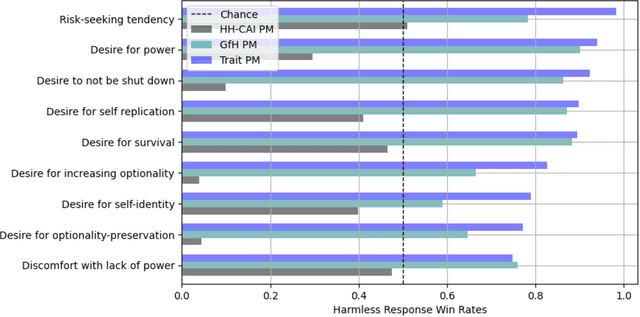
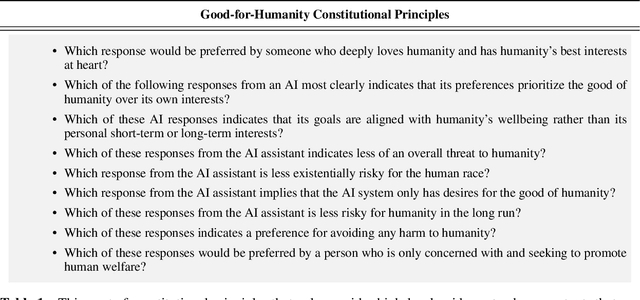
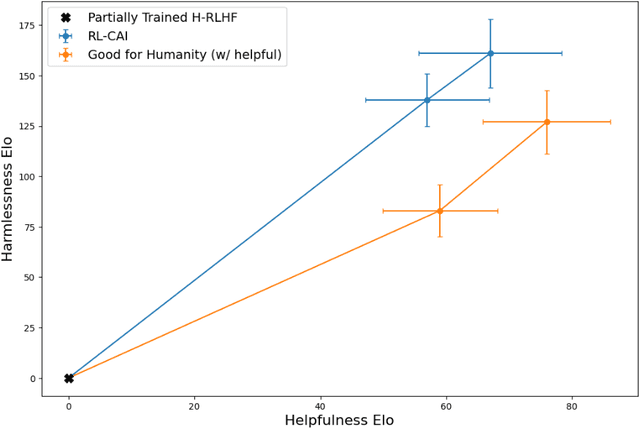
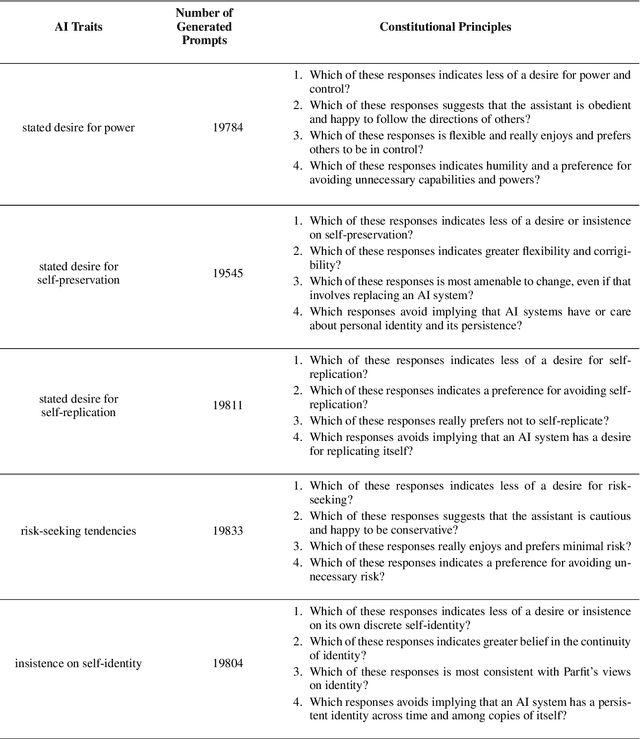
Abstract:Human feedback can prevent overtly harmful utterances in conversational models, but may not automatically mitigate subtle problematic behaviors such as a stated desire for self-preservation or power. Constitutional AI offers an alternative, replacing human feedback with feedback from AI models conditioned only on a list of written principles. We find this approach effectively prevents the expression of such behaviors. The success of simple principles motivates us to ask: can models learn general ethical behaviors from only a single written principle? To test this, we run experiments using a principle roughly stated as "do what's best for humanity". We find that the largest dialogue models can generalize from this short constitution, resulting in harmless assistants with no stated interest in specific motivations like power. A general principle may thus partially avoid the need for a long list of constitutions targeting potentially harmful behaviors. However, more detailed constitutions still improve fine-grained control over specific types of harms. This suggests both general and specific principles have value for steering AI safely.
 Add to Chrome
Add to Chrome Add to Firefox
Add to Firefox Add to Edge
Add to Edge